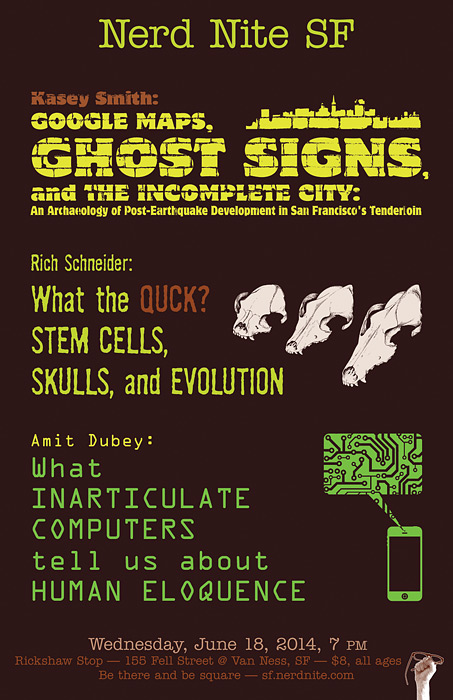 Mysterious messages in fading paint, chimerical quests in skull research, and computers providing talk therapy to human language: A veritable panoply of nerdiness will be emanating from our presenters and their laptops this month. No June Gloom here, what with cocktails, music, grilled cheese, and firing synapses to warm us up. Be there and be square!
Mysterious messages in fading paint, chimerical quests in skull research, and computers providing talk therapy to human language: A veritable panoply of nerdiness will be emanating from our presenters and their laptops this month. No June Gloom here, what with cocktails, music, grilled cheese, and firing synapses to warm us up. Be there and be square!
Wednesday, 6/18/2014
Doors at 7 pm, show at 8
Rickshaw Stop, 155 Fell St @Van Ness
$8, all ages
Tickets available here!
Co-curated with our friends at the Brilliant!Science Festival at the California Academy of Sciences.
———————
“Google Maps, Ghost Signs, and the Incomplete City: An Archaeology of Post-Earthquake Development in San Francisco’s Tenderloin” by Kasey Smith
After the 1906 earthquake, SF’s redevelopment was swift but uneven, with redevelopment of the Tenderloin taking many years. During this period, ads were painted on buildings only to be covered by new construction. The resulting “ghost signs,” which have emerged over the years as the city changes, can often be viewed on foot or with satellite images to see onto rooftops and behind buildings. What stories of yesteryear can we learn from studying these mysterious ads and signs?
Kasey is an artist focusing on the history of Bay Area urban space. For the past three years she’s been working on a project to document, research, and map all of San Francisco’s ghost signs.
———————
“What the Quck? Stem Cells, Skulls, and Evolution” by Rich Schneider
In the science-fiction tradition of H.G. Wells and The Island of Doctor Moreau, Rich Schneider’s fascination with the origins of animal form runs deep. He will explain how his efforts to understand the way dog skulls get shaped ultimately led him to create a stem cell transplant system whereby duck embryos grow quail-like beaks in chimeric creatures he calls quck. Not only do quck walk like duck, quack like quail, and taste like chicken, they also teach us much about how our own faces get patterned.
Now a faculty member in UCSF’s department of orthopedic surgery, Rich published his first paper on the skulls of dogs and wolves when he was still an undergraduate. Over the past 20 years, he has focused on molecular and cellular mechanisms underlying skull development and evolution.
———————
“What Inarticulate Computers Tell Us About Human Eloquence” by Amit Dubey
In 2011, IBM’s Watson and Apple’s Siri brought the science fiction of talking computers to the real world–but no one has thrown away their keyboards or touch screens yet! And today Shit Siri Says lambasts egregious failures as much as it hails the wit of “her” engineers. It might be surprising, then, that computers are helping psychologists better understand how we use language. This talk’ll explain how, uncovering a dirty little secret kept by psycholinguists, the awkward sentences that make their hearts flutter, and the computer programs that bring both together.
This talk describes (in part) work done by Amit while a postdoc at the University of Edinburgh. He currently works at Google.
———————
With: Alpha Bravo, who’ll be spinning tunes specially selected to match the presenters’ themes. Follow the setlist on Twitter @djalphabravo.
And: Come hungry for the Grilled Cheese Guy, who’ll be upstairs slinging sammies!